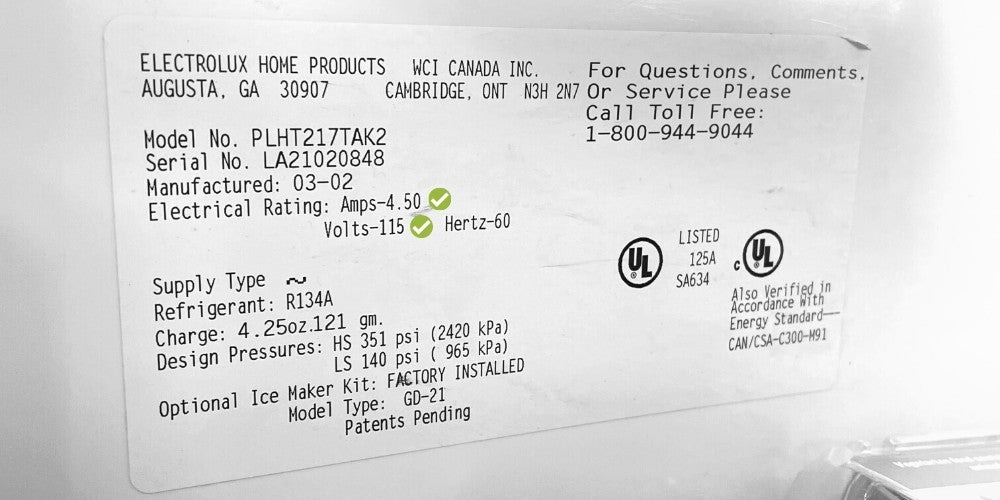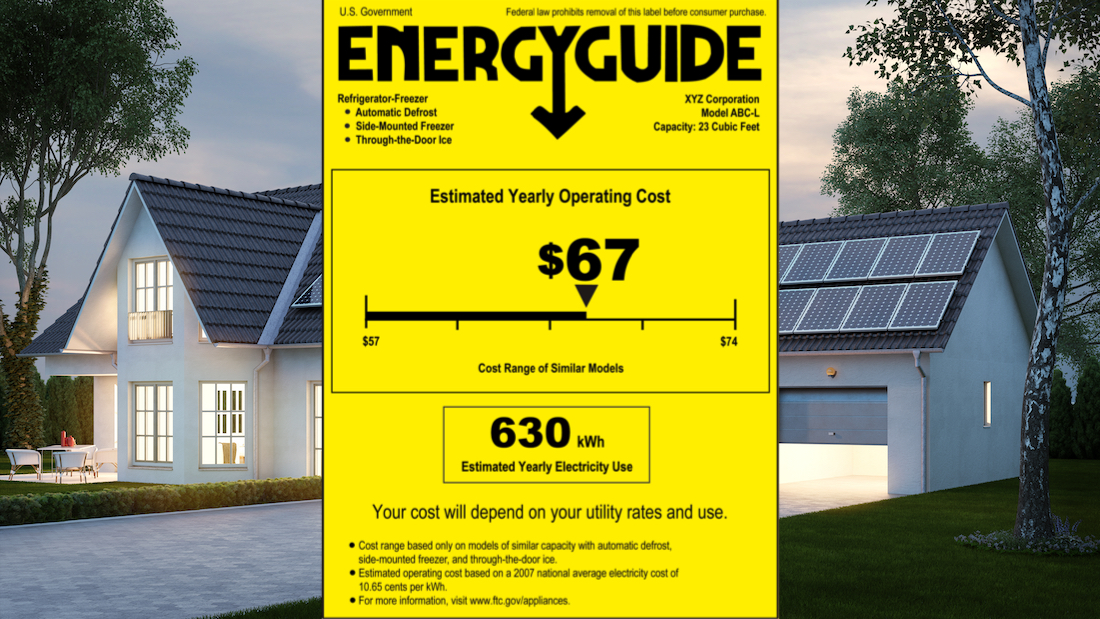Updated 7 months ago
How Many Watts Does a Refrigerator Use?
Written by
Dan Simms

Find out how many solar panels can cover your electricity usage and lower your bills
Most refrigerators use between 300 and 800 watts, with an average power rating of 500 watts.
While your refrigerator might not be the most power-hungry appliance in your home, it’s one of the hardest-working, as the compressor can run for 30% to 80% of the day to keep your food cold. Because it’s working for most of the day, it consumes quite a bit of energy.
With electricity prices steadily increasing, you’re not alone in wondering how many watts your refrigerator uses and how much it’s costing you. Let’s discuss average refrigerator consumption rates, what impacts them, and how to reduce your refrigerator’s energy usage.
Key takeaways
-
The average refrigerator uses 500 watts of power, but power ratings can range from 300 to 800 watts.
-
Most refrigerators will use about 6 kWh of energy per day.
-
It costs about $29.10 to power a refrigerator for a month, but actual costs will vary with your fridge, how you use it, and the electric rates in your area.
-
You can figure out how much energy your refrigerator uses by looking at the label on the back of your fridge that shows the amperage and voltage.
-
By keeping your refrigerator coils clean, setting the correct temperature, and not overstocking it, you can help reduce the amount of power your fridge uses.
How many watts does an average refrigerator use?
Most refrigerators need between 300 and 800 watts, with an average power rating of 500 watts.
The wattage of your refrigerator tells you how much power the appliance needs to run at any given time. Your home refrigerator’s wattage can vary by the model, how old it is, and its size. Older refrigerators will use more power to run, while newer energy-efficient models will use less.
How much does it cost to run a refrigerator?
It costs an average of $0.96 per day to run a refrigerator, which equates to roughly $29.10 per month or $350 annually. Refrigerator power consumption and costs will depend on its running wattage, how long it’s running for, and the electricity rates in your area. The table below shows how much it costs to power a refrigerator, based on how many hours per day it runs:
Daily run time | Daily energy usage (kWh) | Estimated monthly cost |
|---|---|---|
6 hours | 3 kWh | $14.55 |
8 hours | 4 kWh | $19.41 |
10 hours | 5 kWh | $24.26 |
12 hours | 6 kWh | $29.10 |
14 hours | 7 kWh | $33.95 |
16 hours | 8 kWh | $38.80 |
Based on a 500-watt refrigerator and the national average electric rate from the Energy Information Administration
Remember, your actual cost will vary widely based on the local cost of electricity. In Hawaii, which has the highest cost per kilowatt-hour (kWh) in the country, running a fridge costs an average of $887 per year, while residents in North Dakota, where electricity prices are lowest, pay just $217 per year.
Should I unplug my refrigerator to save money on electricity costs? Generally, it’s not worth it to unplug your refrigerator to try and save energy. While the fridge won’t be running and could hold the temperature you need for a few hours, it will end up using more power to start up and come back to temperature when you plug it back in.
How to calculate how much energy your fridge uses
There are a few ways to calculate how much electricity your fridge uses, depending on your situation and what information you have access to.
Use the energy consumption label

You can look for the energy consumption label on your refrigerator to calculate how many watts the refrigerator will use. This usually won’t give you a rating in watts, but it will tell you how many amps your refrigerator uses, as well as the voltage. You can use the following formulas to convert these numbers to power draw in watts and annual electricity consumption.
Watts = volts x amps
In the image above, the amperage is 4.5, and the voltage is 115. Let’s plug those numbers into the equation above.
4.5 amps x 115 volts = 517.5 watts
From there, you can estimate the consumption by assuming your fridge runs for 50% of the day, or 12 hours daily.
(517.5 watts x 12 hours) / 1,000 = 6.21 kWh per day
Check the ENERGY STAR label

Image adapted from the Federal Trade Commission
Refrigerators that were made after 1996 and are certified by ENERGY STAR will have a yellow sticker on them that estimates the annual consumption and average annual running cost. Check the sides and back of the fridge for the label, or check ENERGY STAR’s product database for the make and model.
The label includes an annual running cost and an annual consumption, and these should be reasonably close to accurate numbers for your appliance, although they are averages.
Test using a smart electrical panel
The most accurate way to determine how many kWh your refrigerator uses per day is to test the actual consumption for an entire day. This is really only possible if you have a smart electrical panel or home energy management system that provides individual appliance monitoring. If you do have this feature, simply check your app to see how much energy your refrigerator pulls on an average day. Some popular brands of smart electrical panels include the SPAN panel and the Lumin panel.
7 factors that affect how much electricity a refrigerator uses
There are many factors at play when it comes to estimating how much electricity your refrigerator uses. Understanding the role each of these plays can help you use your fridge more efficiently and even reduce your electric bills.
How to reduce how much electricity your fridge uses
According to the EIA, just under 7% of a home’s electricity consumption goes toward powering refrigerators and freezers. Electricity prices have doubled since 2005, and that trend will likely continue for the foreseeable future, as electricity demand increases and supply dwindles. There are a few energy-saving things you can do to decrease how much electricity your fridge uses and also to reduce your energy bills in general.
Upgrade to a new model: Refrigerators have come a long way in the past few decades, and they’re more efficient now than ever before. If your fridge is nearing its lifespan, consider upgrading early to an ENERGY STAR-certified model. You may be able to get more functionality while using less energy and still enjoy monthly savings.
Use proper temperature settings: Set your refrigerator to 37 degrees and your freezer to 0 degrees Fahrenheit. These settings strike a balance between food safety, preservation, and energy efficiency.
Be more mindful about opening the fridge: Simply being a bit more intentional about using your fridge can reduce energy consumption. Try to plan out what you’ll remove before you open the fridge doors, and be sure to close them when you’re not actively taking things out or putting in new groceries.
Don’t overstock it with groceries: Speaking of new groceries, overstocking your fridge can reduce airflow inside, which makes your condenser work harder to keep all of the contents cool. Space groceries out, and do your best to buy only what you plan to use over the following week or so.
Carry out routine maintenance: Schedule annual maintenance for your fridge to keep it running at peak efficiency. In between professional servicing, you can clean the condenser coils on the back of the fridge and remove any frost and ice build-up in your freezer to help boost efficiency and reduce power usage.
How do I reduce or even eliminate my power bill?
If you’re on this page, it’s probably because you’re concerned about your energy costs. You can make changes to your daily habits to conserve more energy, or perform a home energy audit to identify how you can save electricity.
The best way to reduce or even eliminate your power bill is by installing solar panels.
To find out how much solar panels could save you on power costs, use our solar calculator. It will tell you how many solar panels you need, recommended system size, estimated savings over 25 years, plus it can help you connect with local solar companies.
Dan has been a solar proponent for more than a decade now, and he has been researching and writing about solar and renewable energy for the past five years. He has first-hand experience with solar conversion, and he uses that and his research to help homeowners lower their electric bills and reduce their carbon footprint through solar education and adoption. He has written for major publications, including CNN, USA Today, and EcoWatch, and he has...
Learn more about Dan Simms